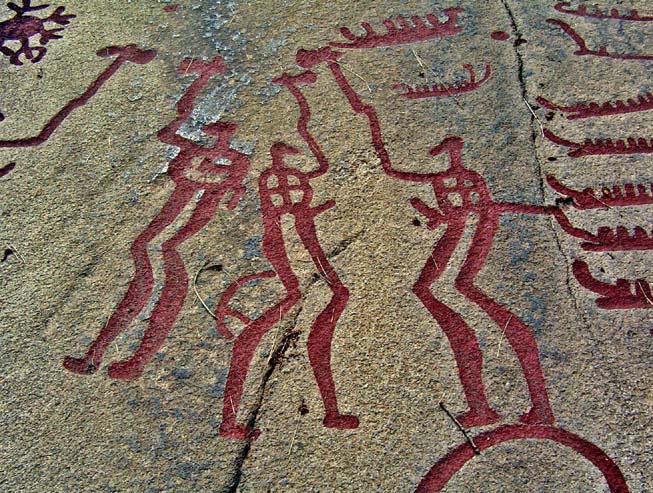The Rock Drawings
Archeological records for the early Germanic peoples are sparse; plus there is an inherent difficulty with tying early finds to a particular language,
and thus identifying them as Germanic.
The earliest and most useful evidence in Scandinavia is in fact pictorial: large numbers of drawings carved into rock faces (petroglyphs). These are found
in Norway, Sweden, and Denmark (although there are few in Denmark and only on the slabs that form the outside of ancient graves; Denmark lacks the rock
outcroppings of the other Scandinavian countries); some are dated as early as 6000 BCE, but most are dated to the Nordic Bronze Age (1800-500 BCE). The
motifs that appear in these - wagons, men wearing swords and a man with a double-headed axe, above all ships - give us precious clues to the earliest forms
of Germanic culture in Scandinavia. They have been related to bronze wagons with discs and female figures in them found in burials; to the ship burials of
later times; to movements of population (some show large fleets of ships with many people standing in them; others appear to show foreign ships, in one case
apparently Egyptian, suggesting trading or battles); to Thor/Thunor/Donar and his hammer (in one picture a figure holds the axe high over two other figures,
perhaps a wedding blessing). More abstract designs suggest votive practices: the cross within a circle design used by some modern heathens, and circular
indentations into which liquid may have been poured - both libations and lamp oil have been suggested.

Detail of a rock carving from Tanum, Västra Götaland, Sweden
Photo taken by Fred J retouched by Locutus Borg, Wikimedia Commons
[1. Old Norse, ca 900 image from http://upload.wikimedia.org/wikipedia/commons/9/97/Tanumshede_2005_rock_carvings_5.jpg]
